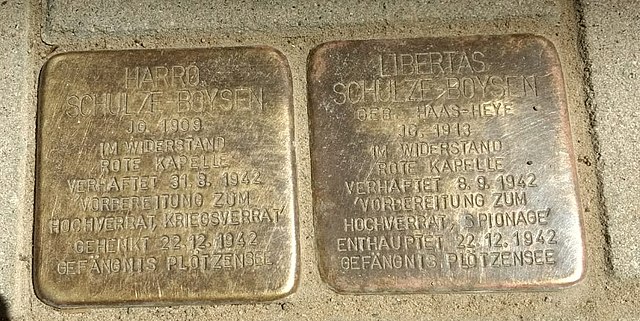Libertas "Libs" Schulze-Boysen, born Libertas Viktoria Haas-Heye was a German Prussian noblewoman, who became a resistance fighter against the Nazis. From the early 1930s to 1940, Schulze-Boysen attempted to build a literary career, first as a press officer and later as a writer and journalist. Initially sympathetic to the Nazis, she changed her mind after meeting and marrying Luftwaffe officer Harro Schulze-Boysen. As an aristocrat, Schulze-Boysen had contact with many different people in different strata of German society. Starting in 1935, she utilized her position to recruit left-leaning Germans into discussion groups which she hosted at her and Harro's apartment, where they sought to influence her guests. Through these discussions, resistance to the Nazi regime grew, and by 1936, she and Harro began to actively resist the Nazis. During the early 1940s, whilst working as a censor for the German Documentary Film Institute, Schulze-Boysen began to document atrocities committed by the Nazis from photographs of war crimes forwarded by soldiers of the Sonderbehandlungen task force to the Film Institute.

Bust of Libertas at Castle Liebenberg
Liebenberg Castle
Libs and Harro. The picture was taken in 1935
Stolperstein for the Schulze-Boysens in the castle courtyard of Liebenberg Castle
Plötzensee Prison is a men's prison in the Charlottenburg-Nord locality of Berlin with a capacity for 577 prisoners, operated by the State of Berlin judicial administration. The detention centre established in 1868 has a long history; it became notorious during the Nazi era as one of the main sites of capital punishment, where about 3,000 inmates were executed. Famous inmates include East Germany's last communist leader Egon Krenz.
Plötzensee Prison
Exterior sign at Plötzensee Memorial, 1984
Plötzensee Memorial, 2005
Peter Buchholz; "OMGUS MILITARY TRIBUNAL – CASE THREE OMT-III-W-56 / Witness Peter Buchholz, former prison chaplain at the Berlin-Plötzensee Prison, who described prison conditions there. He stated that there were people executed there during his time for whom stay of execution papers were in processing, perhaps even reprieve action."








